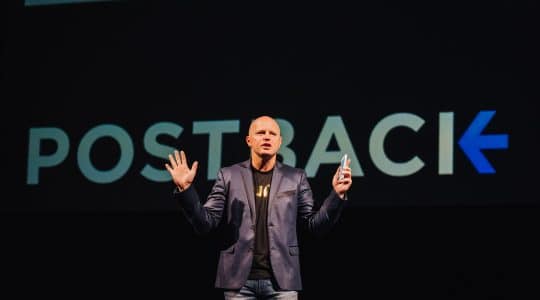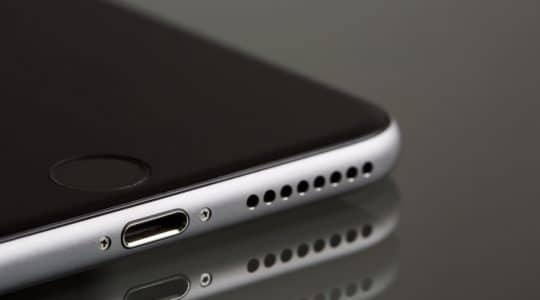“Competitors are disrupting the industry, and customers are changing their expectations based on those disruptions. Then they’re projecting those expectations onto you.” — Jennifer Wise
Personalization is king
Mobile has raised the bar on personalization. At least, that’s the message Jennifer Wise delivered during her lightning keynote at Postback 2017. And as a Forrester Research senior analyst who spends all day studying customer experience, mobile and emerging interfaces, and UX, we’re inclined to believe her.
“Personalization is one of the most hyped terms I’m hearing from companies today,” said Wise. “Why? Because everybody is doing it. Google, Netflix, Lyft, Amazon … these personalized experiences are changing the way we do the most basic tasks.”
Add that to the continually-evolving technologies and opportunities mobile brings with it, and that bar just keeps rising. (Can you still see it up there?) Today’s companies, especially those that rely heavily on mobile or apps, need to keep up — or risk losing sight of it altogether.
But why personalization? Why not fancy UI, or awesome AR, or even (gasp!) just giving away free stuff or coupons?
For starters, six out of 10 adults online in the U.S. have chosen, recommended, or shelled out more cash for a brand that provides them with a personalized service or experience. And Wise says a whopping 68% of companies have made delivering personalized experiences a priority. Not just a goal — a priority. (She also predicts that chatbots and intelligent agents, like Siri and Alexa, will raise the bar even higher.)
How to add personalization to your marketing strategy
Keeping up with personalization on a Google or Amazon level may seem like a daunting task. Don’t worry; there are a few things you can start to do today to follow their lead.
First, we need to understand just how drastically mobile has changed the way we do marketing:
- Who? targeting customer segments —> targeting individuals
- What? sending pre-fabricated messages through pre-planned channels —> sending personalized content through optimal touchpoints
- When? triggered by company event —> push-based communications triggered by a customer event
- Where? any location —> an explicit location
- Why? proactive interactions that serve the business, or reactive communications that serve the customer —> proactive interactions that serve the customer and the business
Now combine mobile with personalization, and you get smart consumers that expect their interactions with your business to be individualized, valuable, and contextual. To meet those raised expectations (and keep that bar in sight), marketers need to make the shift to providing and communicating four key things to their audience:
- I have information to help you.
- I can simplify things for you.
- I think you might need this.
- I care about you.
Doing this isn’t easy. Wise says many companies face challenges when trying to achieve personalization, with 51% reporting a lack of funding/resources, and 44% reporting they don’t have the right technology.
Now that you know what kinds of personalization consumers find most valuable, it’s time to figure out how to provide it. According to Wise, these are the most popular user experience areas that companies are personalizing today:
- Content on the website: 64%
- Reminders and alerts: 47%
- Product recommendations: 44%
- Promotions/product offers: 41%
- Screen layout: 39%
- Content on the mobile app experience: 30%
- In-person engagement: 16%
Do these areas align with your business model? Or is there a unique opportunity specific to your brand or product that’s not listed here? Determine where personalization could make the biggest impact for your customers, and focus your efforts there.
That bar is starting to look a little closer, isn’t it?
Here’s an IDEA to get you started
To wrap up her keynote, Wise described the IDEA cycle, a process that marketers can use “to build a pragmatic personalization program.” The IDEA cycle has four steps:
- Identify key personalization moments
- Design personalized experiences: their tasks and your goals
- Engineer your processes, platforms, and products for personalized interactions
- Analyze to optimize outcomes and improve customers’ experiences
Remember, the customer journey is still just a hypothesis. And you’ll never have all the answers. But you can focus on areas where you can: help inform the situation; guide them to what they need; extend their options to advise them of other things they may need; and enhance the experience to deliver a great experience.
Visit our video playlist to find more keynotes and highlights from Postback 2017.
Author
Becky is the Senior Content Marketing Manager at TUNE. Before TUNE, she handled content strategy and marketing communications at several tech startups in the Bay Area. Becky received her bachelor's degree in English from Wake Forest University. After a decade in San Francisco and Seattle, she has returned home to Charleston, SC, where you can find her strolling through Hampton Park with her pup and enjoying the simple things between adventures with friends and family.


![MobileBest: Why Mobile-First Is Not Enough [Forrester Report]](https://www.tune.com/wp-content/uploads/2014/05/10271381_567497496692301_6627834864492579971_o-540x300.jpg)

hi,
this is very nice speech as well as his is so motivated information given from your side ,
thank for this posting ,
regards,
mansi desai